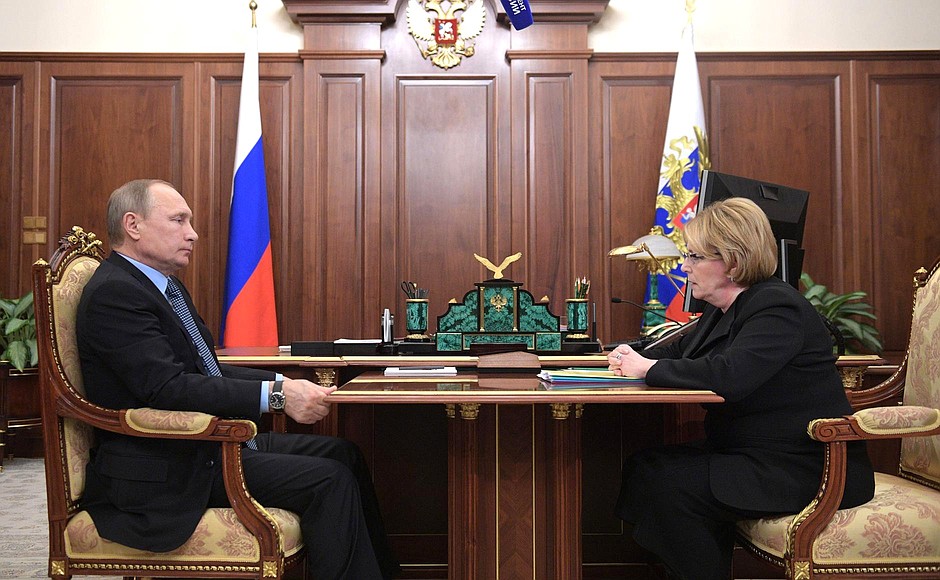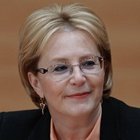
President of Russia Vladimir Putin: Ms Skvortsova, the Address to the Federal Assembly devoted a large section to healthcare development. Let us start with this.
Healthcare Minister Veronika Skvortsova: Thank you very much, Mr President.
We continue active efforts to improve the situation with maternity and children’s healthcare provision. Ten new perinatal centres opened this year. Another five will be ready by the end of the year, and we will open 17 more such centres over the course of next year. As you instructed, in 2016–2017, we will complete the work to establish a three-tier system for healthcare provision for expectant mothers and newborn children.
We are already seeing the results. Over the first 10 months of this year, the infant mortality rate stood at 5.9 per 1,000 live births. This represents a drop of close to 11 percent over this period. Maternal mortality has also decreased quite sharply.
Vladimir Putin: Did you say 5.9?
Veronika Skvortsova: 5.9 is the infant mortality rate, and the maternal mortality rate stands at 10 per 100,000 women giving birth.
Vladimir Putin: 5.9 – is this better than in Europe?
Veronika Skvortsova: Yes, it is better than in the European region as defined by the WHO: the rate there is 6.5–6.6. It is also better than in America, where the rate is 6.6.
Vladimir Putin: Good.
Veronika Skvortsova: I think we will be able to improve these results over the coming years.
The other area that you spoke about was high-tech medical care.
Over this year, we have increased considerably the amount of additional medical care provided. The figure for the year so far comes to around 900,000 patients treated. I think the overall figure for the year will be around 940,000.
Acting on your instructions, we adopted the federal law on a new system for financing high-tech medical care this year. This new system is being actively implemented now. This will enable us to maintain our growth rates next year and treat at least 960,000 patients, and in 2018, we aim to treat more than a million patients a year.
In other words, for the first time in our history, we will be in a position to satisfy the public’s annual demand for high-tech medical care. This means that we will no longer have waiting lists for treatment. The waiting lists have already shortened substantially. Adults now wait around three weeks for treatment, and children less than two weeks. There are already no waiting lists at all for many kinds of treatment.
You set the important objective of improving the quality of primary medical care and defined two principal areas: improving medical workers’ training and qualifications, and improving actual working conditions, particularly using new digital technologies and widespread computerisation in the healthcare system.
Mr President, we are working actively in this area. This year, we established a website for ongoing medical education. This site now runs around 6,000 educational programmes, including 2,000 designed for doctors working at the primary healthcare level. We are continuing to build on this and we now have a huge expert community covering all the main areas of medicine, who are designing these educational programmes. Next year, we should have at least 10,000–15,000 programmes.
These programmes allow doctors to set the individual educational track they want to follow. They can choose from three modules that cover not only theoretical training but also work in simulator training centres and internships at the workplace.
We already have 35,000 doctors using the site. Of course, with around 700,000 doctors currently working in the healthcare system in total, we hope to make this system universal over the next few years.
We have also developed interactive modules that enable doctors to raise their qualifications and that can calculate the degree of knowledge acquisition with useful result. We have developed 548 such modules this year. Next year, we will bring this up to around 1,000, and around 2,000 in 2018.
This is the best system in the world and it is has proven its effectiveness as a means for letting doctors continue their education right from the workplace. Sixty-five percent of doctors’ workspaces are computerised now, especially at the primary healthcare level. We hope to bring this figure up to at least 98 percent by the end of 2018.
We are thus opening up completely new opportunities that include not only workspaces connected to all the different databases, but also distance learning, online paperwork, which saves up to 30 percent of doctors’ working time, a structured working day and many other positive aspects.
Simultaneously, in order to improve the situation for local general practitioners, we have reviewed all of the paperwork that doctors encounter, and we did away with 20 documents in 2015, so that now, doctors only fill out three forms. Furthermore, some functions have been transferred to paramedical staff, and each medical centre now has an office where paramedics see patients.
We are continuing our work in this direction and hope to carry out your instructions with the greatest possible efficiency.
Allow me to say a few words about our efforts in developing information technology in the sector. We are currently working on a unified national information system for the sector. A draft law has been drawn up and has already gone through the government approval process. It concerns obligations to connect the different regional segments to the system.
Today, 57 percent of medical centres and hospitals have rapid internet connection. You gave us two years to complete this process and work together with the Communications Ministry to connect the entire system (we depend on their fibre-optic cables and technical capability, of course). More than 14,000 medical organisations are connected now. Of this number, slightly more than 6,500 are connected to the unified secure and standardised national system, and slightly more than 4,500 are using medical information software.
We therefore drew up roadmaps for each region, setting out the timetable for carrying out computerisation programmes based on 12 global modules, and we are monitoring their implementation very closely. We hope to complete the bulk of this work over the next couple of years, by the end of 2018, and we will then continue fine-tuning the system over another two years.
By the start of 2019, every person covered by the compulsory medical insurance system should have their own electronic medical file. Starting next year, we are opening personal accounts for patients on the state services site. This will be in the form of a separate window – My Health, and will offer various user-friendly services. People will start using this system next year, and the main services will all be connected in 2018.
Mr President, we will do our best to ensure that the instructions you gave in your Address are carried out with maximum efficiency and on schedule.
Vladimir Putin: Ms Skvortsova, there has undoubtedly been progress, but, as I said in my Address, and as you are well aware yourself, there are still many problems and many tasks to resolve. I therefore hope that you will take all of this into account in your work next year.
Veronika Skvortsova: Thank you very much. Yes, of course we will do this.
<…>
